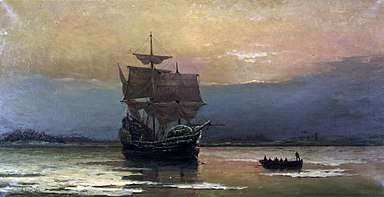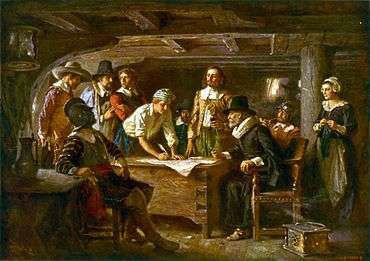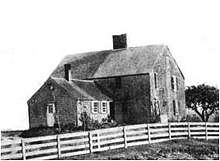John Alden

Capt. John Alden Sr. (c. 1598–1687)[1] was a crew member on the historic 1620 voyage of the Pilgrim ship Mayflower. Rather than return to England with the ship, he stayed at what became Plymouth Colony. He was hired in Southampton, England, as the ship's cooper, responsible for maintaining the ship's barrels. He was a signatory to the Mayflower Compact. He married fellow Mayflower passenger Priscilla Mullins, whose entire family perished in the first winter.
He served in a number of important government positions such as Assistant Governor, Duxbury Deputy to the General Court of Plymouth, Captain Myles Standish's Duxbury militia company, a member of the Council of War, Treasurer of Plymouth Colony, and Commissioner to Dartmouth.[2]
English origins
Many theories have been ventured about the English origins of John Alden. The definitive modern survey of each of them was published by Alicia Crane Williams in 1989-1991.[3] Robert Charles Anderson, general editor of the multi-decade "Great Migration" effort to establish everything known and unknown about the earliest European immigrants to New England, says that although one or two of the hypothesized origins are "tempting," none of them are proved.[4]
Research by historian Charles Edward Banks published in 1929 theorized that John Alden may have come from the Alden family of Harwich in Essex, England.[5] Harwich is an ancient North Sea port, northeast of London, which was the homeport of the Pilgrim ship Mayflower and home of its captain, Christopher Jones. The Alden family of Harwich had distant connections to Jones, residing there in the 17th century and possibly related to him by marriage. The only certainty about his English background were Bradford's words that Alden "was hired for a cooper, (barrel maker) at Southampton, where the ship victuled; and being a hopeful young man, was much desired, but left to his liking to go or stay when he came here; but he stayed, and maryed here." Author Charles Banks states that the employment of Alden "at Southampton" does not necessarily mean that he was a resident of the seaport and may have only been there to work temporarily when the Mayflower arrived. Banks notes a young John Alden about the same age as the Mayflower passenger was a seafarer in Harwich in the early 17th century.
Banks also reports that John Alden, said to have been born in 1599, residing in Southampton in 1620, may have been the son of George Alden the fletcher (arrow maker), who disappeared – probably dying in that year – leaving John, an orphan, free to take overseas employment. Jane, the widow, may have been his mother and Richard and Avys his grandparents. The tax list of Holyrood Ward in 1602 list the names of George Alden and John's future father-in-law William Mullins.[6][5]
Voyage of the Mayflower

The Mayflower departed Plymouth, England, on September 6, 1620. The 100-foot ship had 102 passengers and a crew of about 30-40 in extremely cramped conditions. By the second month out, the ship was being buffeted by westerly gales, causing the ship's timbers to be badly shaken with caulking failing to keep out sea water, and with passengers, even in their berths, lying wet and ill. This, combined with a lack of proper rations and unsanitary conditions for several months, attributed to what would be fatal for many, especially the majority of women and children. On the way, there were two deaths, a crew member and a passenger, but the worst was yet to come. After arriving at their destination, in the space of several months, almost half the passengers perished in the cold, harsh, unfamiliar New England winter.[7]
On November 9, 1620, after a month of delays in England and about two months at sea, they spotted the Cape Cod Hook. After several days of trying to get south to their planned destination of the Colony of Virginia, strong winter seas forced them to return to the harbor at Cape Cod Hook, now called Provincetown Harbor, where they anchored on November 11. The Mayflower Compact was signed that day.[7][8]
In Plymouth Colony

John Alden was among the original settlers of the Plymouth Colony. Although not himself a Separatist, he had been hired to be a cooper (barrel maker) and decided to join the journey when she set sail, perhaps with the hope of becoming prosperous in the New World. Alden's rivalry with Miles Standish for the affection of Priscilla Mullins is recounted elaborately in Henry Wadsworth Longfellow's poem "The Courtship of Miles Standish" (1858).
From 1633 until 1675, he was assistant to the governor of the Plymouth Colony, frequently serving as acting governor and also on many juries.
Dispute of 1634
In 1634, Alden was jailed, in Boston, for a fight at Kenebeck in Maine between members of the Plymouth Colony and the Massachusetts Bay Colony. The fight involved a fur trading dispute that escalated into a killing of Plymouth colonist Moses Talbot by John Hocking by a shot to the head. Hocking was then immediately killed by Plymouth colonists by a shot to the head.[9][10]
While Alden did not participate in the fight, he was the highest-ranking member from Plymouth that the Massachusetts Bay colonists found to arrest. It was only through the intervention of Bradford that he was eventually released.
Family
John Alden married Priscilla Mullins on May 12, 1622. She was the only survivor of the Mayflower Mullins family. They had ten children. Priscilla died in Duxbury between 1651 and her husband's death in 1687. Both were buried in the Myles Standish Burial Ground in Duxbury, Massachusetts.[1][11] John Alden was an extreme ancestor to president John Adams and his family. A direct descendant of John was Scott Alden (1907–1977), who served as an assistant to FBI Director J. Edgar Hoover.[12]
Children of John Alden and Priscilla Mullins
- Elizabeth was born in 1623 and died in Little Compton, Rhode Island, on May 31, 1717. She married William Pabodie on December 26, 1644 in Duxbury MA, and had thirteen children. Her grave and that of her husband are in the Old Commons Cemetery in Little Compton.
- John Jr. was born about 1626 and died in Boston on March 14, 1701/2. He married Elizabeth (Phillips) Everill on April 1, 1660, and had fourteen children. He was a survivor of the Salem witch trials, of which he wrote a notable account.
- Joseph was born about 1628 and died in Bridgewater on February 8, 1696/7. He married Mary Simmons about 1660 and had seven children.
- Priscilla was born about 1630. She married Samuel Cheeseborough in 1699.[1]
- Jonathan was born about 1632 and died in Duxbury on February 14, 1697. He married Abigail Hallett on December 10, 1672, and had six children. Jonathan was buried in the Old Cemetery in South Duxbury.[1]
- Sarah was born about 1634 and died before the settlement of her father's estate in 1688. She married Alexander Standish about 1660 and had eight children.[1]
- Ruth was born about 1636 and died in Braintree on October 12, 1674. She married John Bass in Braintree on February 3, 1657/8, and had seven children.[1] Among her children was Hannah Bass, paternal grandmother of future United States President John Adams.
- Mary was born about 1638. She married Thomas Delano before 1667 and they had one child.[1]
- Rebecca was born in 1649 and died in 1688. She is buried in The Old Burying Ground (Myles Standish Cemetery) in Duxbury, Massachusetts. She was mentioned in the Colonial Records to be of marriageable age in 1661. [1]
- David was born about 1642 and died in Duxbury between July 2, 1718, and April 1, 1719. He married Mary Southworth by 1674 and had six children.[1]
Final days and legacy

John Alden was the last survivor of the signers of the Mayflower Compact. He died at Duxbury[13] on September 12, 1687. Both he and his wife Priscilla lie buried in the Myles Standish Burial Ground.
The Alden residence is also in Duxbury, on the north side of the village, on a farm which is still in possession of their descendants of the seventh generation. He made no will, having distributed the greater part of his estate among his children during his lifetime.[14]
A wheel-lock carbine owned by John Alden is housed at the NRA's National Firearms Museum; it is the only known surviving firearm to have crossed the Atlantic aboard the Mayflower. The rifle was found hidden in the Alden house during a 1924 restoration.[15][16]
John Alden's House, now a National Historic Landmark, was built in 1653 and is open to the public as a museum. It is run by the Alden Kindred of America, an organization which provides historical information about him and his home, including genealogical records of his descendants. John and Priscilla had the following children who survived to adulthood: Elizabeth, John (accused during the Salem witch trials), Joseph, Priscilla, Robert, Jonathan, Sarah, Ruth, Mary, Rebecca, and David. They have the most descendants today of all the pilgrim families.[17]
References
- 1 2 3 4 5 6 7 8 9 Plimoth Plantation and the New England Historic Genealogical Society. "A genealogical profile of John Alden". Plimoth Plantation website. Retrieved 9 December 2017.
- ↑ Alden, Augustus Ephraim. Pilgrim Alden: the story of the life of the first John Alden in America (Boston: James H. Earle and Company: 1902). pp. 84-86. Retrieved 9 December 2017.
- ↑ Alicia Crane Williams, 'John Alden: Theories on English Ancestry', The Mayflower Descendant 39: 111-22 (1989), 40: 133-26 (1990), 41: 201 (1991).
- ↑ Robert Charles Anderson, The Pilgrim Migration: Immigrants to Plymouth Colony 1620-1633 (Boston: New England Historic Genealogical Society, 2004), p. 9. Accessed 9 December 2017.
- 1 2 Charles Edward Banks, The English Ancestry and Homes of the Pilgrim Fathers: who came to Plymouth on the Mayflower in 1620, the Fortune in 1621, and the Anne and the Little James in 1623 (Baltimore, MD.:Genealogical Publishing Co., 2006, originally published 1929) pp. 27–28. Retrieved 9 December 2017.
- ↑ Eugene Aubrey Stratton. Plymouth Colony: Its History and People, 1620-1691, (Salt Lake City: Ancestry Publishing, 1986), pp. 232–233.
- 1 2 Eugene Aubrey Stratton. Plymouth Colony: Its History and People, 1620-1691, (Salt Lake City: Ancestry Publishing, 1986), p. 413.
- ↑ George Ernest Bowman, The Mayflower Compact and its signers, (Boston: Massachusetts Society of Mayflower Descendants, 1920). Photocopies of the 1622, 1646 and 1669 versions of the document pp. 7–19.
- ↑ Caleb Johnson. "John Alden". Mayflower History.com. Retrieved 9 December 2017.
- ↑ Johnson, Caleb. Of Plymouth Plantation: Along with the full text of the Pilgrims' journals for their first year at Plymouth. p. 577. ISBN 9781462822386.
- ↑ The Graves of Myles Standish and Other Pilgrims
- ↑ "Former Aide to Hoover Burial Slated Today". The Tennessean. Nashville, Tennessee. December 14, 1977. p. 24. Retrieved April 9, 2016.
- ↑ Duxbury, in other records, a.k.a. Duxburrough, Duxborough, Duxboro.
- ↑ Alden 1867, p. 2.
- ↑ Kristin Alberts, Thanksgiving's First Rifle: The Mayflower Wheel-lock Carbine, American Digest. Retrieved 9 December 2017.
- ↑ "Mayflower Wheellock Carbine", NRA Museums. Retrieved 9 December 2017.
- ↑ Alden, Ebenezer. "Memorial of the Descendants of the Hon. John Alden". S.P. Brown, 1867 p. 1.
Sources
- Alden, Ebenezer. "Memorial of the Descendants of the Hon. John Alden". S.P. Brown, 1867
- Addison, Daniel Dulany. "The Life and Times of Edward Bass, First Bishop of Massachusetts". Houghton, Mifflin, 1897
- National Society of Colonial Dames. "First Record Book of the Society of Colonial Dames", 1897; Ch.75
- Waters, Henry Fitz-Gilbert. "The New England Historical and Genealogical Register". New England Historic Genealogical Society, 1898; p. 435-440
- Longfellow, H.W. "The Courtship of Miles Standish", 1858
- Hawthorne, Julian. "The History of the United States from 1492 to 1910 Volume 1: 1492-1910". BiblioBazaar, LLC, 2007. ISBN 1-4264-8541-7, ISBN 978-1-4264-8541-1.; p. 61-62
External links
| Wikisource has the text of the 1911 Encyclopædia Britannica article Alden, John. |
- John Alden MayflowerHistory.com page with vital facts and references.
- John Alden House & Alden Kindred of America
- John Alden at Find A Grave